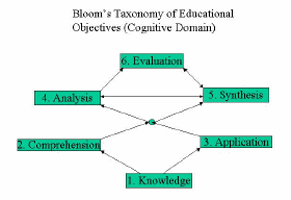Developing Questions for Gallery Walk to Engage Higher Order Thinking
 This material was originally created for
Starting Point:Introductory Geology
This material was originally created for
Starting Point:Introductory Geology and is replicated here as part of the SERC Pedagogic Service.
Gallery Walk involves preparing questions based around a lecture's central concept, issue, or debate. The wording of the question depends on the desired learning skill or level of abstraction. A variety of questions can be used but the technique seems to work best with higher order questions relating to analysis, evaluation, and synthesis. A good way to frame questions for Gallery Walk is to use Bloom's Hierarchy see Bloom's Taxonomy and Critical Thinking ( This site may be offline. ) which provides a guide for wording questions at various levels of abstraction.
Below are Bloom Hierarchy key words (taken verbatim from the resource above) that can be used to frame questions. A couple of examples of questions follow. For a more extensive listing of possible examples go to section on Sample Questions for Gallery Walk
Examples of "Knowledge" level questions - recall of facts

- List the earth's major tectonic plates.
- What molecule in the stratosphere protects against ultraviolet radiation?
Examples of "Comprehension" level questions - understanding and stating key concepts or main ideas
Key Words: summarize, rephrase, explain, interpret, compare, contrast, outline, translate.
- What is the difference between weathering and erosion?
- Draw a several diagrams outlining the development of an oxbow lake.
Examples of "Application" level questions - applying knowledge in new ways and in novel situations
Key Words: apply, solve, model, make use of, organize, experiment with, use.
- If the top of this test page represents north, use an arrow to indicate a southwest wind.
- Use Darcy's Law to calculate groundwater flow rates (m/s) in location A and in location B.
Examples of "Analysis" level questions - breaking down information into key components, finding evidence
Key Words: analyze, find evidence for, examine, inference, assumption, categorize, conclusion, classify, compare, contrast, discover, dissect, inspect, simplify, relationships.
- What inference can you make about the geomorphic history of this region based on the location and form of terraces?
- What evidence exists in this soil profile that this soil should be classified as an entisol rather than an inceptisol?
Examples of "Synthesis" level questions - combining elements in a novel way, proposing alternate solutions
Key Words: combine, create, design, develop, build, compile, compose, construct, formulate, imagine, invent, make up, originate, plan, predict, propose, change, improve, adapt, improve, change.
- Make recommendations for the current coastal zoning plan in order to better protect property from hurricane damage.
- Create a field check list for identifying outcrops prone to mass wasting.
Examples of "Evaluation" level questions - making judgements based on accepted standards
Key Words: criticize, defend, dispute, evaluate, judge, justify, recommend, rule on, agree, appraise, assess.
- Criticize arguments made in a creationist web site based on the laws and theories of science.
- Defend, using sound scientific evidence, the use of Yucca Mountain as a nuclear waste repository.
Reference
Bloom,B. Mesia, B. and Krathwohl, D. 1964. Taxonomy of Educational Objectives (two vols: The Affective Domain & The Cognitive Domain). New York. David McKay.
Image Source: Air War College, 2004. Bloom's Taxonomy, http://www.au.af.mil/au/awc/awcgate/edref/bloom4.htm, accessed 12 November 2004.
